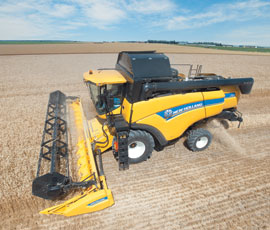Grass rotation benefits wheat yields in NE

Harvest is making very slow progress in Northumberland, but wheat yields are proving fantastic, says Sentry Farming’s Andrew Crewdson.
“Harvest is becoming a nightmare; all the winter barley and rapeseed is done, and 60% of the oats, but wheat is only about 10% through, and we haven’t even started spring barley up here.”
He reckoned harvest at Blagdon Farming and Hartley Main Farms, Newcastle, was about 35% complete, with showers causing long delays.
“The crops are ready but the ground is so wet that travelling is a real problem. There’s also straw lying everywhere, and people wanting to clear fields to drill oilseed rape.”
The Sentry team had cut 80ha (200 acres) of Viscount wheat, with average yields of 10t/ha (4t/acre).
“In the second field the combine driver sent me a photo of the combine’s yield monitor at 21.2t/ha (8.6t/acre).
“I thought it was a joke, but it was right – and we calibrate the combine against the weighbridge constantly, so we know it’s accurate within 3%.”
Many parts of the 14ha (35-acre) field averaged 17-18.5t/ha (7-7.5t/acre), but with the headlands included it finished off at 13.5t/ha (5.47t/acre) dry weight.
“The funny thing is that it’s the worst field on the farm – we call it Dangerfield – it gets so wet that one year in five we’ll be lucky to get on it. I wanted to plant trees on it.”
With a beef and dairy unit, Mr Crewdson decided to change the farm’s rotation in 2008, and sowed the field to grass and clover as a two-year silage ley.
“We had amazing yields of grass – then we min-tilled it into wheat on 19 September last year, and had this great crop of wheat.
“Another field which had the same growing treatment but wasn’t after grass did 10.4t/ha (4.2t/acre).
“Grass is now part of our rotation under the Higher Level Stewardship scheme – and it just shows you the possibilities of what can be achieved when everything goes right.”
Wheat yields in the area had generally been pleasing, he added. “But bushelweights are only average, even though the ears are massive.”
Oilseed rape had also yielded well, at 4.4t/ha (1.8t/acre), with high erucic Palmedor at 3.5t/ha (1.4t/acre).
“We cut most of the oilseed rape at 18% moisture, but I’m glad we did.
“However, our winter barley was appalling. It was drilled at the end of September in wet conditions, and really suffered, at under 5t/ha (2t/acre).”
Spring barley looked well, as did the spring wheat. “We’re going to introduce spring barley into the rotation, rather than using it as default after a wet autumn.”
Crop: Winter wheat
Variety: Viscount
Area: 80ha (200 acres)
Yield: 10t/ha (4t/acre)
Crop: Oilseed rape
Varieties: Excalibur, Catana and Compass
Area: 120ha (300 acres)
Yield: 4.4t/ha (1.8t/acre)
Crop: Winter barley
Variety: Pearl
Yield: <5t/ha (2t/acre)

